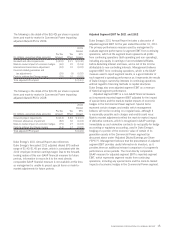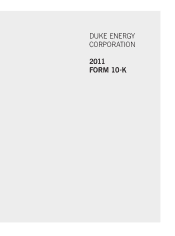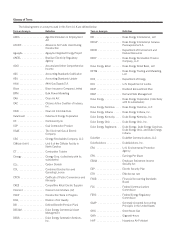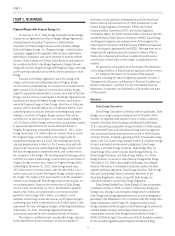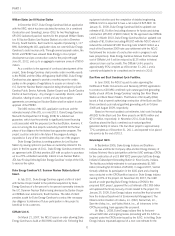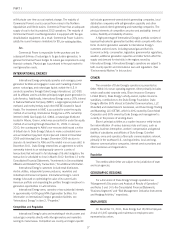Duke Energy 2011 Annual Report Download - page 27
Download and view the complete annual report
Please find page 27 of the 2011 Duke Energy annual report below. You can navigate through the pages in the report by either clicking on the pages listed below, or by using the keyword search tool below to find specific information within the annual report.
PART I
conditions. Industrial sales increased modestly in 2011 when
compared to 2010; however, the growth rate was lower than in
previous comparable periods.
Seasonality and the Impact of Weather
USFE&G’s costs and revenues are influenced by seasonal
patterns. Peak sales of electricity occur during the summer and winter
months, resulting in higher revenue and cash flows during those
periods. By contrast, fewer sales of electricity occur during the spring
and fall, allowing for scheduled plant maintenance during those
periods. Peak gas sales occur during the winter months. Residential
and commercial customers are most impacted by weather. Industrial
customers are less weather sensitive. Normal weather conditions are
defined as the long-term average of actual historical weather
conditions.
The estimated impact of weather on earnings is based on the
number of customers, temperature variances from a normal condition
and customer’s historic usage levels and patterns. The methodology
used to estimate the impact of weather does not and cannot consider
all variables that may impact customer response to weather
conditions such as humidity and relative temperature changes. The
precision of this estimate may also be impacted by applying long-
term weather trends to shorter term periods.
Competition
USFE&G’s regulated utility business operates as the sole
supplier of electricity within certain service territories. It owns and
operates all of the businesses and facilities necessary to generate,
transmit and distribute electricity. Services are priced by state
commission approved rates designed to include the costs of providing
these services and a reasonable return on invested capital. This
regulatory policy is intended to provide safe and reliable electricity at
fair prices. USFE&G’s competition in the regulated electric distribution
business is primarily from the on-site generation of industrial
customers. USFE&G also competes with other utilities and marketers
in the wholesale electric business. The principal factors in competing
for wholesale sales are price (including fuel costs), availability of
capacity and power and reliability of service. Wholesale electric prices
are influenced primarily by market conditions and fuel costs.
Energy Capacity and Resources
For information on USFE&G’s generation facilities, see “U.S.
Franchised Electric and Gas” in Item 2. “Properties”.
Electric energy for USFE&G’s customers is generated by three
nuclear generating stations with a combined owned capacity of
5,173 megawatt (MW) (including Duke Energy’s 19.25% ownership
in the Catawba Nuclear Station), 14 coal-fired stations with an overall
combined owned capacity of 12,977 MW (including Duke Energy’s
69% ownership in the East Bend Steam Station and 50.05%
ownership in Unit 5 of the Gibson Steam Station), 31 hydroelectric
stations (including two pumped-storage facilities) with a combined
owned capacity of 3,321 MW, 15 combustion turbine (CT) stations
burning natural gas, oil or other fuels with an overall combined
owned capacity of 5,012 MW, and two Combined Cycle (CC)
stations burning natural gas with an owned capacity of 905 MW. In
addition, USFE&G operates a solar Distributed Generation program
with 9 MW of capacity. Energy and capacity are also supplied
through contracts with other generators and purchased on the open
market. Factors that could cause USFE&G to purchase power for its
customers include generating plant outages, extreme weather
conditions, generation reliability during the summer, growth, and
price. USFE&G has interconnections and arrangements with its
neighboring utilities to facilitate planning, emergency assistance, sale
and purchase of capacity and energy, and reliability of power supply.
USFE&G’s generation portfolio is a balanced mix of energy
resources having different operating characteristics and fuel sources
designed to provide energy at the lowest possible cost to meet its
obligation to serve native-load customers. All options, including
owned generation resources and purchased power opportunities, are
continually evaluated on a real-time basis to select and dispatch the
lowest-cost resources available to meet system load requirements.
The vast majority of customer energy needs have historically been
met by large, low-energy-production-cost nuclear and coal-fired
generating units that operated almost continuously (or at baseload
levels). However, recent commodity pricing trends have resulted in
more combined cycle gas-fired generation.
Hydroelectric (both conventional and pumped storage) facilities
in the Carolinas and gas/oil CT and CC stations in both the Carolinas
and Midwest operate primarily during the peak-hour load periods
when customer loads are rapidly changing. CT’s and CC’s are less
expensive to build and maintain than either nuclear or coal, and can
be rapidly started or stopped as needed to meet changing customer
loads or operated as base load units depending on commodity prices.
Hydroelectric units produce low-cost energy, but their operations are
limited by the availability of water flow.
USFE&G’s pumped-storage hydroelectric facilities offer the
added flexibility of using low-cost off-peak energy to pump water that
will be stored for later generation use during times of higher-cost
on-peak periods. These facilities allow USFE&G to maximize the
value spreads between different high- and low-cost generation
periods.
USFE&G is engaged in planning efforts to meet projected load
growth in its service territories. Long-term projections indicate a need
for capacity additions, which may include new nuclear, integrated
gasification combined cycle (IGCC), coal facilities, gas-fired generation
units or renewable energy facilities. Because of the long lead times
required to develop such assets, USFE&G is taking steps now to
ensure those options are available. Significant current or potential
future capital projects are discussed below.
In 2007, North Carolina and South Carolina passed energy
legislation which includes provisions to provide assurance of cost
recovery, subject to prudency review, related to a utility’s incurrence
of project development costs associated with nuclear baseload
generation, cost recovery assurance for construction costs associated
with nuclear or coal baseload generation, and the ability to recover
financing costs for new nuclear baseload generation in rates during
construction.
7


